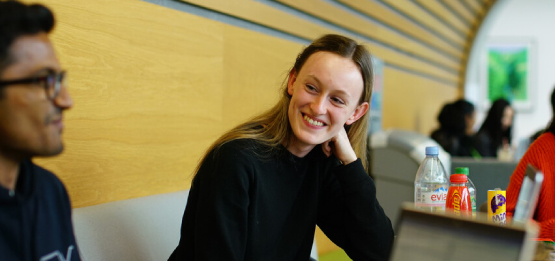Mathematics and Physics BSc (UCAS GF13)
General entry requirements
A levels
A level typical offer
A*AA to include A* in Mathematics, A in Further Mathematics and A in Physics.
For students not taking A level Further Mathematics, the typical offer is A* (Mathematics), A* (Physics) and A in a third subject at A level.
A level contextual offer
We welcome applications from candidates who meet the contextual eligibility criteria and whose predicted grades are close to, or slightly below, the contextual offer level. The typical contextual offer is A*AB including A* in A Level Maths plus either A in A Level Further Maths and B in A Level Physics, or A in A Level Physics and B in a third A Level. See if you’re eligible.
General GCSE requirements
Unless specified differently above, you will also need a minimum of GCSE grade 4 or C (or an equivalent qualification) in English Language and either Mathematics or a Science subject. Find out more about our entry requirements and the qualifications we accept.
We advise that you also check the English Language requirements for your course which may specify a higher GCSE English requirement. Please find the information about this below.
IB
IB typical offer
38 to include 7 in Higher Level Mathematics ('Analysis and Approaches' only) and 6 in Higher Level Physics
IB contextual offer
We welcome applications from candidates who meet the contextual eligibility criteria and whose predicted grades are close to, or slightly below, the contextual offer level. The typical contextual offer is 36 including 7 in Higher Level Mathematics ('Analysis and Approaches' only) and 6 in Higher Level Physics. See if you’re eligible.
General GCSE requirements
Unless specified differently above, you will also need a minimum of GCSE grade 4 or C (or an equivalent qualification) in English Language and either Mathematics or a Science subject. Find out more about our entry requirements and the qualifications we accept.
We advise that you also check the English Language requirements for your course which may specify a higher GCSE English requirement. Please find the information about this below.
BTEC
We will consider applications from students taking a BTEC in a relevant Science/Engineering alongside A level Maths and Further Maths on an individual basis.
International qualifications
Language requirements
All applicants have to meet our English Language requirements. If you cannot demonstrate that you meet these, you may be invited to take part in our Pre-sessional English course at Warwick.
Frequently asked questions
Warwick may make differential offers to students in a number of circumstances. These include students participating in a Widening Participation programme or who meet the contextual data criteria.
Differential offers will usually be one or two grades below Warwick’s standard offer.
All students who successfully complete the Warwick IFP and apply to Warwick through UCAS will receive a guaranteed conditional offer for a related undergraduate programme (selected courses only).
Find out more about standard offers and conditions for the IFP.
We welcome applications for deferred entry.
We do not typically interview applicants. Offers are made based on your UCAS form which includes predicted and actual grades, your personal statement and school reference.
Course overview
Mathematics and Physics are complementary disciplines, making them a natural combination for university study. Mathematicians and physicists often address common questions and challenges, resulting in exciting discoveries at the intersection of the two subjects. Ideas developed in particle physics have led to advances in geometry; learning from chaos theory is being applied increasingly in the modelling of complex physical systems such as the atmosphere and lasers.
You will be jointly taught by the Institute of Mathematics and Department of Physics, both of which have a reputation for excellence.
In addition to core modules, you will have flexibility in your second and third years to choose modules to explore areas of interest in more depth. You may also choose to develop a breadth of learning by selecting from approved modules outside the two departments, such as the interdisciplinary module Challenges of Climate Change or learning a modern language.
Study abroad
We support student mobility through study abroad programmes. BSc students have the opportunity to apply for an intercalated year abroad at one of our partner universities.
The Study Abroad Team offers support for these activities. The Department's Study Abroad Co-ordinator can provide more specific information and assistance.
Core modules
The Warwick joint degree course is among the best established in the country and the course includes a number of modules from both contributing departments designed specifically for joint degree students.
In the first year you take essential (core) modules in both mathematics and physics. At the end of the first year it is possible to change to either of the single honours courses, providing you satisfy certain requirements in the end of year examinations.
In the second and third years, there is considerable freedom to choose modules. By then you will have a good idea of your main interests and be well placed to decide which areas of mathematics and physics to study in greater depth.
Year One
Analysis I/II
Analysis is the rigorous study of calculus. In this module, there will be a considerable emphasis throughout on the need to argue with much greater precision and care than you had to at school. With the support of your fellow students, lecturers, and other helpers, you will be encouraged to move on from the situation where the teacher shows you how to solve each kind of problem, to the point where you can develop your own methods for solving problems. The module will allow you to deal carefully with limits and infinite summations, approximations to pi and e, and the Taylor series. The module ends with the construction of the integral and the Fundamental Theorem of Calculus.
Sets and Numbers
It is in its proofs that the strength and richness of mathematics is to be found. University mathematics introduces progressively more abstract ideas and structures, and demands more in the way of proof, until most of your time is occupied with understanding proofs and creating your own. Learning to deal with abstraction and with proofs takes time. This module will bridge the gap between school and university mathematics, taking you from concrete techniques where the emphasis is on calculation, and gradually moving towards abstraction and proof.
Linear Algebra
Linear algebra addresses simultaneous linear equations. You will learn about the properties of vector space, linear mapping and its representation by a matrix. Applications include solving simultaneous linear equations, properties of vectors and matrices, properties of determinants and ways of calculating them. You will learn to define and calculate eigenvalues and eigenvectors of a linear map or matrix. You will have an understanding of matrices and vector spaces for later modules to build on.
Methods of Mathematical Modelling I and II
In this module you will learn the modelling cycle and learn to analyse simple models, using scaling, non-dimensionalisation and linear stability analysis to understand the main dynamics. This will require the basic theory of ordinary differential equations (ODEs), the cornerstone of all applied mathematics. ODE theory later proves invaluable in branches of pure mathematics, such as geometry and topology. You will be introduced to simple differential and difference equations, methods for their solution and numerical approximation.
In the second term you will study the differential geometry of curves, calculus of functions of several variables, multi-dimensional integrals, calculus of vector functions of several variables (divergence and circulation), and their uses in line and surface integrals.
Physics Foundations
You will look at dimensional analysis, matter and waves. Often the qualitative features of systems can be understood (at least partially) by thinking about which quantities in a problem are allowed to depend on each other on dimensional grounds. Thermodynamics is the study of heat transfers and how they can lead to useful work. Even though the results are universal, the simplest way to introduce this topic to you is via the ideal gas, whose properties are discussed and derived in some detail. You will also cover waves. Waves are time-dependent variations about some time-independent (often equilibrium) state. You will revise the relation between the wavelength, frequency and velocity and the definition of the amplitude and phase of a wave.
Electricity and Magnetism
You will largely be concerned with the great developments in electricity and magnetism, which took place during the nineteenth century. The origins and properties of electric and magnetic fields in free space, and in materials, are tested in some detail and all the basic levels up to, but not including, Maxwell's equations are considered. In addition, the module deals with both dc and ac circuit theory including the use of complex impedance. You will be introduced to the properties of electrostatic and magnetic fields, and their interaction with dielectrics, conductors and magnetic materials.
Classical Mechanics and Special Relativity
You will study Newtonian mechanics emphasizing the conservation laws inherent in the theory. These have a wider domain of applicability than classical mechanics (for example they also apply in quantum mechanics). You will also look at the classical mechanics of oscillations and of rotating bodies. It then explains why the failure to find the ether was such an important experimental result and how Einstein constructed his theory of special relativity. You will cover some of the consequences of the theory for classical mechanics and some of the predictions it makes, including: the relation between mass and energy, length-contraction, time-dilation and the twin paradox.
Quantum Phenomena
This module explains how classical physics is unable to explain the properties of light, electrons and atoms. (Theories in physics, which make no reference to quantum theory, are usually called classical theories.) It covers the most important contributions to the development of quantum physics including: wave-particle 'duality', de Broglie's relation and the Schrodinger equation. It also looks at applications of quantum theory to describe elementary particles: their classification by symmetry, how this allows us to interpret simple reactions between particles and how elementary particles interact with matter.
Physics Programming Workshop
You will be introduced to the Python programming language in this module. It is quick to learn and encourages good programming style. Python is an interpreted language, which makes it flexible and easy to share. It allows easy interfacing with modules, which have been compiled from C or Fortran sources. It is widely used throughout physics and there are many downloadable free-to-user codes available. You will also look at the visualisation of data. You will be introduced to scientific programming with the help of the Python programming language, a language widely used by physicists.
Year Two
Analysis III
In this module, you will learn methods to prove that every continuous function can be integrated, and prove the fundamental theorem of calculus. You will discuss how integration can be applied to define some of the basic functions of analysis and to establish their fundamental properties. You will develop a working knowledge of the Riemann integral; understand uniform and pointwise convergence of functions; study complex differentiability (Cauchy-Riemann equations) and complex power series; study contour integrals, Cauchy's integral formulas and applications.
Methods of Mathematical Physics
On this module, you will learn the mathematical techniques required by second-, third- and fourth-year physics students. Starting with the theory of Fourier transforms and the Dirac delta function, you will learn why diffraction patterns in the far-field limit are the Fourier transforms of the ‘diffracting’ object before moving to diffraction more generally, including in the light of the convolution theorem. You will also be introduced to Lagrange multipliers, co-ordinate transformations and Cartesian tensors, which will be illustrated with examples of their use in physics.
Multivariable Calculus
There are many situations in pure and applied mathematics where the continuity and differentiability of a function f: R n. → R m has to be considered. Yet, partial derivatives, while easy to calculate, are not robust enough to yield a satisfactory differentiation theory. In this module you will establish the basic properties of this derivative, which will generalise those of single-variable calculus. The module will review line and surface integrals, introduce div, grad and curl and establish the divergence theorem.
Norms, Metrics and Topologies
Roughly speaking, a metric space is any set provided with a sensible notion of the “distance” between points. The ways in which distance is measured and the sets involved may be very diverse. For example, the set could be the sphere, and we could measure distance either along great circles or along straight lines through the globe; or the set could be New York and we could measure distance “as the crow flies” or by counting blocks. This module examines how the important concepts introduced in first-year Mathematical Analysis, such as convergence of sequences and continuity of functions, can be extended to general metric spaces. Applying these ideas we will be able to prove some powerful and important results, used in many parts of mathematics.
Partial Differential Equations
The theory of partial differential equations (PDE) is important in both pure and applied mathematics. Since the pioneering work on surfaces and manifolds by Gauss and Riemann, PDEs have been at the centre of much of mathematics. PDEs are also used to describe many phenomena from the natural sciences (such as fluid flow and electromagnetism) and social sciences (such as financial markets). In this module you will learn how to classify the most important partial differential equations into three types: elliptic, parabolic, and hyperbolic. You will study the role of boundary conditions and look at various methods for solving PDEs.
Hamiltonian and Fluid Mechanics
This module looks at the Hamiltonian and Lagrangian formulation of classical mechanics and introduces the mechanics of fluids. Lagrangian and Hamiltonian mechanics have provided the natural framework for several important developments in theoretical physics including quantum mechanics. The field of fluids is one of the richest and most easily appreciated in physics. Tidal waves, cloud formation and the weather generally are some of the more spectacular phenomena encountered in fluids. The module establishes the basic equations of motion for a fluid - the Navier-Stokes equations - and shows that in many cases they can yield simple and intuitively appealing explanations of fluid flows.
Quantum Mechanics and its Applications
In the first part of this module you will use ideas, introduced in the first year module, to explore atomic structure. You will discuss the time-independent and the time-dependent Schrödinger equations for spherically symmetric and harmonic potentials, angular momentum and hydrogenic atoms. The second half of the module looks at many-particle systems and aspects of the Standard Model of particle physics. It introduces the quantum mechanics of free fermions and discusses how it accounts for the conductivity and heat capacity of metals and the state of electrons in white dwarf stars.
Statistical Mechanics, Electromagnetic Theory and Optics
Any macroscopic object we meet contains a large number of particles, each of which moves according to the laws of mechanics (which can be classical or quantum). Yet we can often ignore the details of this microscopic motion and use a few average quantities such as temperature and pressure to describe and predict the behaviour of the object. Why we can do this, when we can do this and how to do it are discussed in the first half of this module.
We also develop the ideas of first year electricity and magnetism into Maxwell's theory of electromagnetism. Establishing a complete theory of electromagnetism has proved to be one the greatest achievements of physics. It was the principal motivation for Einstein to develop special relativity, it has served as the model for subsequent theories of the forces of nature and it has been the basis for all of electronics (radios, telephones, computers, the lot...).
Year Three
Communicating Science
Employers look for many things in would-be employees. Sometimes they will be looking for specific knowledge, but often they will be more interested in general skills, frequently referred to as transferable skills. One such transferable skill is the ability to communicate effectively, both orally and in writing. Over the past two years you may have had experience in writing for an academic audience in the form of your laboratory reports. The aim of this module is to introduce you to the different approaches required to write for other audiences. This module will provide you with experience in presenting technical material in different formats to a variety of audiences.
Optional modules
- Measure Theory
- Topics in Mathematical Biology
- Complex Analysis
- Fluid Dynamics
- Theory of PDEs
- Physics Project
- Quantum Physics of Atoms
- Electrodynamics
- Kinetic Theory
- Condensed Matter Physics
- Scientific Computing
- The Earth and Its Atmosphere
- Plasma Physics and Fusion
- The Standard Model
- Galaxies and Cosmology
- Statistical Physics
- Physics of Life and Medicine
- Black Holes, White Dwarfs and Neutron Stars
Assessment
Most lecture modules are assessed by 15% coursework and 85% final examinations or by 100% exam, with almost all exams taken in the third term. Essays and projects, such as the final-year project, are assessed by coursework and an oral presentation.
The weighting for each year's contribution to your final mark is 10:30:60 for the BSc courses.
Teaching
We provide a supportive and friendly environment in which to study. You will learn not just from the lectures and laboratories but also from interacting with others on the course, research students and your friends from outside physics.
Class sizes
Lecture size will naturally vary from module to module. The first year core modules may have up to 350 students in a session, whilst the more specialist modules in the later years will have fewer than 100.
The core physics modules in the first year are supported by weekly classes, at which you and your fellow students meet in small groups with a member of the research staff or a postgraduate student.
Tutorials with your personal tutor and weekly supervision sessions are normally with a group of 5 students.
Typical contact hours
You should expect to attend around 14 lectures a week, supported by weekly supervision meetings, problems classes and personal tutorials.
For each 1 hour lecture, you should expect to put in a further 1-2 hours of private study.
Tuition fees
Tuition fees cover the majority of the costs of your study, including teaching and assessment. Fees are charged at the start of each academic year. If you pay your fees directly to the University, you can choose to pay in instalments.
Undergraduate fees
On 4 November the UK government announced an increase in the tuition fee cap for Home students for academic year 2025/26. The University of Warwick’s Executive Board has consequently confirmed a change in fees from the previously advertised rate to £9,535.
Alongside the tuition fee increase, maintenance loans will also rise by 3.1%.
The University expects to increase fees for future years in line with any inflationary uplift as determined by the UK government.
How are fees set?
The UK Government sets tuition fee rates.
To learn more about how the UK student fees and maintenance loans are set, please visit the UK Government websiteLink opens in a new window and UCASLink opens in a new window.
Undergraduate fees
If you are an overseas student enrolling in 2025-26, your annual tuition fees will be as follows:
- Band 1 – £26,290 per year (classroom-based courses, including Humanities and most Social Science courses)
- Band 2 – £33,520 per year (laboratory-based courses, plus Maths, Statistics, Theatre and Performance Studies, Economics, and courses provided by Warwick Business School, with exceptions)
Tuition fees for 2026 entry have not been set. We will publish updated information here as soon as it becomes available, so please check back for updates about 2026 fee rates before you apply.
Fee status guidance
We carry out an initial fee status assessment based on the information you provide in your application. Students will be classified as Home or Overseas fee status. Your fee status determines tuition fees, and what financial support and scholarships may be available. If you receive an offer, your fee status will be clearly stated alongside the tuition fee information.
Do you need your fee classification to be reviewed?
If you believe that your fee status has been classified incorrectly, you can complete a fee status assessment questionnaire. Please follow the instructions in your offer information and provide the documents needed to reassess your status.
Find out more about how universities assess fee status.Link opens in a new window
Additional course costs
As well as tuition fees and living expenses, some courses may require you to cover the cost of field trips or costs associated with travel abroad.
For departmental specific costs, please see the Modules tab on the course web page for the list of core and optional core modules with hyperlinks to our Module Catalogue.
Associated costs can be found on the Study tab for each module listed in the Module Catalogue (please note most of the module content applies to 2025/26 year of study) Information about module specific costs should be considered in conjunction with the more general costs below:
- Core text books
- Printer credits
- Dissertation binding
- Robe hire for your degree ceremony
Further information
Find out more about tuition fees from our Student Finance team and available funding from our Student Funding Support.
Scholarships and bursaries
Learn about scholarships and bursaries available to undergraduate students.
We offer a number of undergraduate scholarships and bursaries to full-time undergraduate students. These include sporting and musical bursaries, and scholarships offered by commercial organisations.
Find out more about funding opportunities for full-time students.Link opens in a new window
If you are an international student, a limited number of scholarships may be available.
Find out more information on our international scholarship pages.Link opens in a new window
You may be eligible for financial help from your own government, from the British Council or from other funding agencies. You can usually request information on scholarships from the Ministry of Education in your home country, or from the local British Council office.
Warwick Undergraduate Global Excellence Scholarship
We believe there should be no barrier to talent. That's why we are committed to offering a scholarship that makes it easier for gifted, ambitious international learners to pursue their academic interests at one of the UK's most prestigious universities.
We provide extra financial support for qualifying students from lower income families. The Warwick Undergraduate Bursary is an annual award of up to £2,500 per annum. It is intended to help with course-related costs and you do not have to pay it back.
As part of the 'City of Sanctuary' movement, we are committed to building a culture of hospitality and welcome, especially for those seeking sanctuary from war and persecution. We provide a range of scholarships to enable people seeking sanctuary or asylum to progress to access university education.
Further information
Find out more about Warwick undergraduate bursaries and scholarships.
Eligibility for student loans
Your eligibility for student finance will depend on certain criteria, such as your nationality and residency status, your course, and previous study at higher education level.
Check if you're eligible for student finance.
Tuition Fee Loan
You can apply for a Tuition Fee Loan to cover your tuition fees. It is non-means tested, which means the amount you can receive is not based on your household income. The Loan is paid directly to the University so, if you choose to take the full Tuition Fee Loan, you won’t have to set up any payments.
Maintenance Loan for living costs
You can apply for a Maintenance Loan towards your living costs such as accommodation, food and bills. This loan is means-tested, so the amount you receive is partially based on your household income and whether you choose to live at home or in student accommodation.
If you’re starting a course on or after 1 August 2021, you usually must have settled or pre-settled status under the EU Settlement SchemeLink opens in a new window to get student finance.
Tuition Fee Loan
If you are an EU student and eligible for student finance you may be able to get a Tuition Fee Loan to cover your fees. It is non-means tested, which means the amount you may receive is not based on your household income. The Loan is paid directly to the University so, if you choose to take the full Tuition Fee Loan, you won't have to set up any payments.
Help with living costs
If you struggle to meet your essential living costs, our Student Funding team Link opens in a new windowwill be on hand to offer advice and support.
There are a number of options that may be available to you including government, bursary and/or hardship support. Warwick also has a number of bursaries and scholarships Link opens in a new windowthat you may be eligible to apply for.
Repaying your loans
You will repay your loan or loans gradually once you are working and earning above a certain amount. For students starting their course after 1 August 2023, the repayment threshold is £25,000. Repayments will be taken directly from your salary if you are an employee. If your income falls below the earnings threshold, your repayments will stop until your income goes back up above this figure.
Find out more about repaying your student loanLink opens in a new window.
Placements and work experience
All students can apply for research vacation projects - small research projects supervised by a member of academic staff. BSc students can register for the Intercalated Year Scheme, which involves spending a year in scientific employment or UK industry between their second and final year.
Your career
Graduates from this course have gone on to work for employers including:
- Deloitte Digital
- Brunei Shell Petroleum
- British Red Cross
- EDF Energy
- Civil Service
- Deutsche Bank
They have pursued roles such as:
- Physical scientists
- Finance and investment analysts
- Programmers and software development professionals
- Graphic designers
- Researchers
Helping you find the right career
Our department has a dedicated professionally qualified Senior Careers Consultant. They offer impartial advice and guidance together with workshops and events throughout the year. Previous examples of workshops and events include:
- Career options with a Physics Degree
- Careers in Science
- Warwick careers fairs throughout the year
- Physics Alumni Evening
- Careers and Employer networking event for Physics students
Physics at Warwick
Physics is about beautiful ideas and deep questions
Physics aims to observe and explain the behaviour of the physical universe. It looks for laws which apply everywhere and to everything. One of the joys of physics is seeing how a simple principle, established after studying one problem, can go on to explain seemingly unrelated phenomena.
Find out more about us on our website
Our courses
Our three-year courses
Our flexible courses offer excellent teaching informed by our research. You can tailor your course to your interests with optional modules in your later years of study.
- Physics (BSc)
- Physics with Astrophysics (BSc)
- Mathematics and Physics (BSc)
- Physics and Business Studies (BSc)
Our four-year courses
These courses share the same core as the three-year versions. They then let you dig deeper with specialised modules. You'll undertake a dedicated research project as well.
Related degrees

Life at Warwick
Within a close-knit community of staff and students from all over the world, discover a campus alive with possibilities. A place where all the elements of your student experience come together in one place. Our supportive, energising, welcoming space creates the ideal environment for forging new connections, having fun and finding inspiration.

Find out how to apply to us, ask your questions, and find out more.


Warwick Accommodation
Finding the right accommodation is key to helping you settle in quickly.
We have 12 self-catering undergraduate halls of residence on campus.
Our student property management and lettings agency manages more than 8,000 rooms both on and off campus, and provides advice to all full-time undergraduates.

Our campus
You won't be short of ways to spend your time on campus - whether it's visiting Warwick Arts Centre, using our incredible new sports facilities, socialising in our bars, nightclub and cafés, or enjoying an open-air event. Or if you need some peace and quiet, you can explore lakes, woodland and green spaces just a few minutes’ walk from central campus.

Food and drink
We have lots of cafés, restaurants and shops on campus. You can enjoy great quality food and drink, with plenty of choice for all tastes and budgets. There is a convenience store on central campus, as well as two supermarkets and a small shopping centre in the nearby Cannon Park Retail Park. Several of them offer delivery services to help you stay stocked up.
And don't miss our regular food market day on the Piazza with tempting, fresh and delicious street food. Soak up the atmosphere and try something new, with mouth-watering food for all tastes.

Clubs and societies
We currently have more than 300 student-run societies.
So whether you’re into films, martial arts, astronomy, gaming or musical theatre, you can instantly connect with people with similar interests.
Or you could try something new, or even form your own society.

Sports and fitness
Staying active at Warwick is no sweat, thanks to our amazing new Sports and Wellness Hub, indoor and outdoor tennis centre, 60 acres of sports pitches, and more than 60 sports clubs.
Whether you want to compete, relax or just have fun, you can achieve your fitness goals.
Studying on campus
Our campus is designed to cater for all of your learning needs.
You will benefit from a variety of flexible, well-equipped study spaces and teaching facilities across the University.
- The Oculus, our outstanding learning hub, houses state-of-the-art lecture theatres and innovative social learning and network areas.
- The University Library provides access to over one million printed works and tens of thousands of electronic journals
- Three Learning Grids offering you flexible individual and group study spaces.

Travel and local area
Our campus is in Coventry, a modern city with high street shops, restaurants, nightclubs and bars sitting alongside medieval monuments. The Warwickshire towns of Leamington Spa and Kenilworth are also nearby.
The University is close to major road, rail and air links. London is just an hour by direct train from Coventry, with Birmingham a 20-minute trip. Birmingham International Airport is nearby (a 20-minute drive).

Wellbeing support and faith provision
Our continuous support network is here to help you adjust to student life and to ensure you can easily access advice on many different issues. These may include managing your finances and workload, and settling into shared accommodation. We also have specialist disability and mental health support teams.
Our Chaplaincy is home to Chaplains from the Christian, Jewish and Muslim faiths. We provide regular services for all Christian denominations and a Shabbat meal every Friday for our Jewish students. There is also an Islamic prayer hall, halal kitchen and ablution facilities.

How to apply
Learn more about our application process.

Key dates
Key dates for your application to Warwick.

Writing your personal statement
Make an impression and demonstrate your passion for your course.

After you've applied
Find out how we process your application.

Our Admission Statement
Read Warwick's Admission Statement
3 ways to connect
Talk to us
Join us at a live event. You can ask about courses, applying to Warwick, life at Warwick, visas and immigration, and more.
Warwick Experience
Take a virtual, student-led campus tour. Then join an interactive panel session, where you can hear from and chat to our current students and staff.
Student blogs
Explore our student blogs in OurWarwick. You can read about campus life from students themselves, and register to post questions directly to students.
Explore campus with our virtual tour
Our 360 tour lets you:
- Watch student videos
- View 360 photography and drone footage
- Learn about facilities and landmarks
Explore our campus virtually through our 360 campus tour now

Come to an Open Day
Don’t just take it from us, come and see for yourself what Warwick is all about. Whether it's a virtual visit or in-person, our University Open Days give you the chance to meet staff and students, visit academic departments, tour the campus and get a real feel for life at Warwick.
Sign up for updates
Discover more about our courses and campus life with our helpful information and timely reminders.




